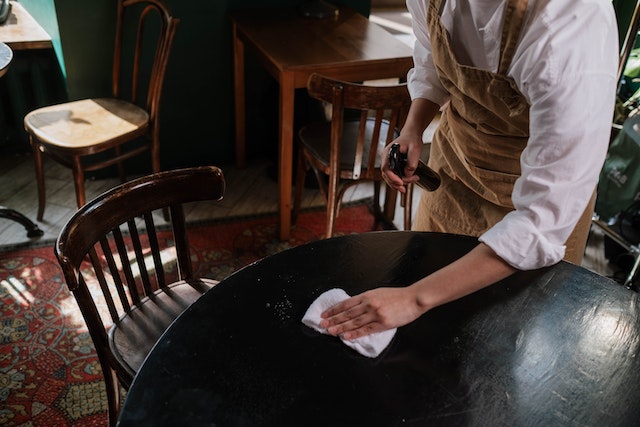A comparative study of four commercially available sanitizers found that an ethanol-based product was significantly more effective in destroying human norovirus (hNoV), and all products tested benefited from a wiping step to physically as well as chemically remove traces of the virus.
The purpose of the study, which was published in Food Microbiology (August 25, 2022), was to assess the anti-hNoV efficacy of various surface sanitizers when applied to a laminate material commonly used for restaurant tabletops.
Researchers from North Carolina State University, in partnership with GOJO, evaluated four products with different active ingredients (ethanol [EtOH], acid + anionic surfactant [AAS], quaternary ammonium compound [QAC] and sodium hypochlorite [NaOCl]) and a water control against two human norovirus strains—hNoV GII.4 Sydney and hNoV GI.6—and the cultivable surrogate Tulane virus (TuV). They used identical spray bottles and a robotic arm to wipe the surfaces to ensure consistency in methods between products.
“We had two major research questions. First, what is the efficacy of sanitizers commonly used by the retail food industry against human norovirus? Second, what is the relative importance of including a wiping step during the sanitizing process?” said Lee-Ann Jaykus, Ph.D., William Neal Reynolds Distinguished Professor of Food Microbiology at North Carolina State University and co-author of the study. “We found that on Formica, only one of the four products tested was able to provide any significant activity against human norovirus; the other three products inactivated only a negligible amount of virus.”
The researchers used controlled antiviral surface assays to assess the relative anti-hNoV efficacy of the sanitizers, and outcomes were compared following 30- and 60-second contact times without wiping and 30- and 60-second contact times with wiping.
Following a 30-second contact time with the EtOH-based product, log10 reductions of 3.6 ± 0.7, 4.1 ± 0.5 and 3.4 ± 0.2 were observed for GII.4, GI.6 and TuV, respectively. Treatment with all other products resulted in statistically significantly lower reductions in viral titer.
Following 60-second contact time with the EtOH-based product log10 reductions of 4.0 ± 0.5, 4.3 ± 0.6 and 6.3 ± 0.5 were observed for GII.4, GI.6 and TuV, respectively. The other formulated or diluted products produced ≤0.5 log10 reductions.
The addition of the wiping step provided greater log10 reductions in virus concentration for all products tested against all viruses.
“The addition of a wiping step to the sanitation process provided removal of 95% to 99.9% of the virus on the surface,” said Dr. Jaykus.
When comparing performance among the three viruses, “The performance against all three viruses was nearly identical for each of the four products,” said Dr. Jaykus. “In other words, if Product A inactivated 50% of one human norovirus strain, it also inactivated around 50% of the other human norovirus strain and the Tulane virus. This tells us that Tulane virus might be a better surrogate than the viruses currently used as proxies for human norovirus upon which to base label claims.”
When the paper towels were processed for residual virus five minutes after wiping, no evidence of residual virus could be detected on the used paper towels with the EtOH-based product treatments. For the NaOCl-based product, no detectable virus was present on spent paper towels used in wiping studies for GII.4 hNoVs, and relatively low concentrations of virus were recovered from paper towels for GI.6 and TuV. For the AAS-based product, the concentrations of virus recovered from the paper towels were approximately 2.3, 1.3 and 1.4 log10 lower than that of the untreated control for GII.4, GI.6 and TuV, respectively. For the QAC-based product and water, the concentration of virus recovered from the paper towels was similar to that of the initial dried inoculum, suggesting low (if any) virus inactivation by the product.
“One of the most interesting findings was that the quaternary ammonium-based compound (QAC) did not show any real anti-noroviral activity against the virus strains tested. This is important because the vast majority of the restaurant and retail sector in the U.S. routinely uses QAC-based products to sanitize tables in dining areas,” said Dr. Jaykus. “Further, we were able to recover infectious virus from paper towels used to wipe contaminated surfaces, which suggests that if the sanitizer does not kill the virus, towels used in wiping could spread viruses if reused on another surface.”





